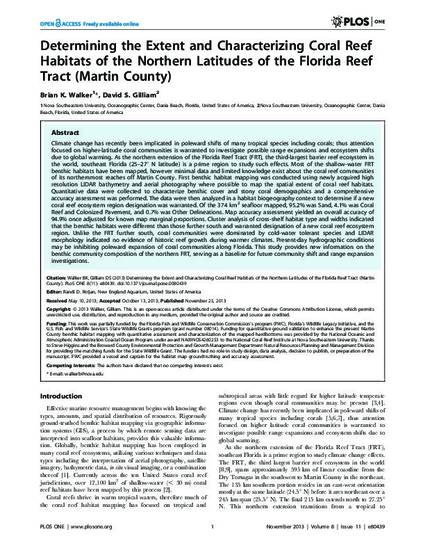
- Beaches,
- Coral reefs,
- Corals,
- Ecosystems,
- Florida,
- Habitats,
- Latitude,
- Sediment
Climate change has recently been implicated in poleward shifts of many tropical species including corals; thus attention focused on higher-latitude coral communities is warranted to investigate possible range expansions and ecosystem shifts due to global warming. As the northern extension of the Florida Reef Tract (FRT), the third-largest barrier reef ecosystem in the world, southeast Florida (25–27° N latitude) is a prime region to study such effects. Most of the shallow-water FRT benthic habitats have been mapped, however minimal data and limited knowledge exist about the coral reef communities of its northernmost reaches off Martin County. First benthic habitat mapping was conducted using newly acquired high resolution LIDAR bathymetry and aerial photography where possible to map the spatial extent of coral reef habitats. Quantitative data were collected to characterize benthic cover and stony coral demographics and a comprehensive accuracy assessment was performed. The data were then analyzed in a habitat biogeography context to determine if a new coral reef ecosystem region designation was warranted. Of the 374 km2 seafloor mapped, 95.2% was Sand, 4.1% was Coral Reef and Colonized Pavement, and 0.7% was Other Delineations. Map accuracy assessment yielded an overall accuracy of 94.9% once adjusted for known map marginal proportions. Cluster analysis of cross-shelf habitat type and widths indicated that the benthic habitats were different than those further south and warranted designation of a new coral reef ecosystem region. Unlike the FRT further south, coral communities were dominated by cold-water tolerant species and LIDAR morphology indicated no evidence of historic reef growth during warmer climates. Present-day hydrographic conditions may be inhibiting poleward expansion of coral communities along Florida. This study provides new information on the benthic community composition of the northern FRT, serving as a baseline for future community shift and range expansion investigations.
Available at: http://works.bepress.com/david-gilliam/33/

©2013 Walker, Gilliam. This is an open-access article distributed under the terms of the Creative Commons Attribution License, which permits unrestricted use, distribution, and reproduction in any medium, provided the original author and source are credited.